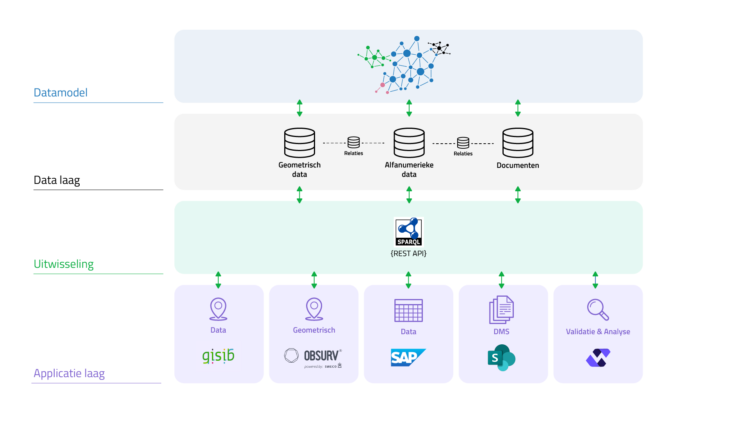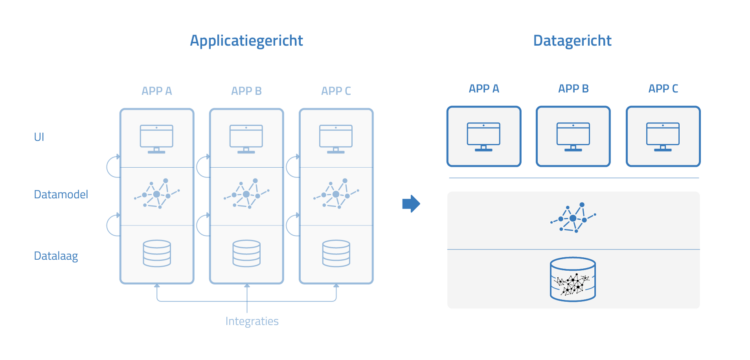Are You in Control of Your Data?
Posted on 30 January 2025 by BIM-Connected
Data-driven work is the future! To gain insights, craft strategies, and make informed decisions based on data, you need reliable, high-quality data. Sounds logical, right? Yet, many organizations still don’t fully own or control their data. Why is that, and how can it be different? Let’s break it down.
The Downside of Application-Centric Work
Most organizations today work application-centrically. This means they purchase applications to support specific processes, like time tracking or managing assets in a system. These applications often come as suites, combining an app, a data structure, and a database. In this setup, data is bundled with applications, making it inaccessible as a standalone resource. Here’s the issue: applications designed for specific tasks view the same asset from different perspectives. Across an organization, this often leads to data quality problems.
Example: Colleague A updates an asset in Application A during Process A. Meanwhile, Colleague B in Process B doesn’t see the update because they’re working in Application B. The result? Inconsistent data across systems.
To avoid this, systems need to be integrated: a change in one application must update across others. Easier said than done!
System integration is time-consuming, expensive (it typically consumes 35-65% of a company’s IT budget!), complex and error-prone. As the number of applications grows, integration issues multiply. If something goes wrong, you’re left wondering which application holds the correct data. Over time, information in these systems becomes less reliable, and the application landscape becomes unmanageable. You lose track of the truth.
Additionally, because data isn’t decoupled from applications, organizations often lack a clear overview of where data resides, why it’s stored, and whether it’s current. This lack of transparency results in data that isn’t accurate, reliable, or complete (ARC). And without trustworthy data, making sound decisions, setting strategies, or gaining insights becomes impossible.
Application-centric work also limits flexibility. For example, if an organization needs to switch to a new application (due to procurement regulations, for instance), they face three significant challenges:
- Migrating data to the new application, which likely has a different structure.
- Rebuilding all integrations the old application had.
- Disrupting workflows—processes may grind to a halt for weeks or even months while data is transferred.
The result? Migration projects are often long, complex, and costly. Organizations can spend millions on temporary fixes, only to find themselves back in the same situation years later.
What Does Work?
To work data-driven, you need access to reliable, relevant data. The key? Put data first. Transition from application-centric to data-centric operations.
The root of the problem lies in inaccessible, hard-to-obtain, and difficult-to-migrate data. The solution? Take full control of your data as an organization and use open standards to structure it.
Open standards ensure that your data isn’t tied to specific vendors or applications. This independence means you won’t lose expertise or functionality when switching systems. A huge win!
The Building Blocks of Data-Centric Work
Traditional application suites bundle data, structure, and functionality. A data-centric approach separates these components:
- Data Structure: The data structure (or data model) is the backbone of your data. It defines what information the organization needs, how it’s connected, and why it’s essential. Transparency starts here.
- Data: Stored independently, your data is based on the defined structure. This separation ensures access, reusability, and adaptability for various needs.
- Applications: Applications become tools, not data owners. They retrieve data, process it, and save results back to the data layer. Applications follow your data strategy—not the other way around.
- Integrations: Integrations connect applications to your centralized data or link data layers with external systems. They manage permissions, defining who can create, read, update, or delete specific data.

Benefits of Data-Centric Work
- Transparency: Clear insights into what data is collected, why, and where it’s stored. This reduces redundancies and costs.
- Ownership: Complete control over your data—always accessible, reusable, and available for insights.
- Trustworthiness: A single source of truth ensures data consistency and reliability across your organization.
- Efficiency: Fewer integrations simplify management and reduce costs.
- Vendor Independence: Minimize lock-ins by separating data from applications.
- No More Migrations: With centralized data, switching applications doesn’t disrupt operations.
- Data First: Applications serve the data strategy, not vice versa.

Do We Need to Overhaul Everything?
Not necessarily. You can keep existing applications, but you’ll need to explicitly define your data structure and create a centralized data layer as your single source of truth. Applications will connect to this layer instead of each other, providing clarity and consistency across the board.
Curious how we can help you embrace data-centric work? Discover our solutions and take control of your data today!